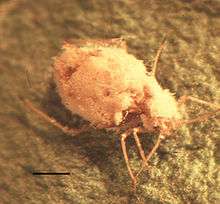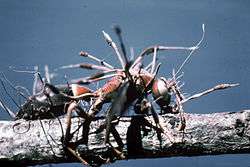Entomopathogenic fungus
An entomopathogenic fungus is a fungus that can act as a parasite of insects and kills or seriously disables them.

Typical life cycle

These fungi usually attach to the external body surface of insects in the form of microscopic spores (usually asexual, mitosporic spores also called conidia). Under the right conditions of temperature and (usually high) humidity, these spores germinate, grow as hyphae and colonize the insect's cuticle; which they bore through by way of enzymatic hydrolysis, reaching the insects' body cavity (hemocoel).[1] Then, the fungal cells proliferate in the host body cavity, usually as walled hyphae or in the form of wall-less protoplasts (depending on the fungus involved). After some time the insect is usually killed (sometimes by fungal toxins), and new propagules (spores) are formed in or on the insect if environmental conditions are again right. High humidity is usually required for sporulation.
Groups

The entomopathogenic fungi include taxa from several of the main fungal groups and do not form a monophyletic group. Many common and/or important entomopathogenic fungi are in the order Hypocreales of the Ascomycota: the asexual (anamorph) phases Beauveria, Isaria (was Paecilomyces), Hirsutella, Metarhizium, Nomuraea and the sexual (teleomorph) state Cordyceps; others (Entomophthora, Zoophthora, Pandora, Entomophaga) belong in the order Entomophthorales of the Zygomycota.
Related fungi attack and kill other invertebrates (e.g. nematodes).
Pest control
Since they are considered natural mortality agents and environmentally safe, there is worldwide interest in the use and manipulation of entomopathogenic fungi for biological control of insects and other arthropod pests. In particular, the asexual phases of Ascomycota (Beauveria spp., Isaria spp., Lecanicillium spp., Metarhizium spp., Purpureocillium spp. and others) are under intense scrutiny due to traits favouring their use as biological insecticides.[2]
Production
Most entomopathogenic fungi can be grown on artificial media. However, some require extremely complex media; others, like Beauveria bassiana and exploitable species in the genus Metarhizium, can be grown on starch-rich substrates like cereal grains (rice, wheat).
Virulence
The Entomophthorales are often reported as causing high levels of mortality (epizootics) in nature. These fungi are highly virulent. The anamorphic Ascomycota (Metarhizium, Beauveria etc.) are reported as causing epizootics less frequently in nature.
Also important for pesticide development are their properties regarding specificity (host range), storage, formulation, and application.
See also
- Biological insecticides
- Entomopathogenic nematode
- LUBILOSA and the desert locust pages for more on use of Metarhizium as a biological insecticide.
References
- Fernandes EG, Valério HM, Feltrin T, Van Der Sand ST (2012). "Variability in the production of extracellular enzymes by entomopathogenic fungi grown on different substrates". Braz. J. Microbiol. 43 (2): 827–33. doi:10.1590/S1517-83822012000200049. PMC 3768820. PMID 24031896.
- Strasser H, Vey A, Butt TM (28 June 2010). "Are There any Risks in Using Entomopathogenic Fungi for Pest Control, with Particular Reference to the Bioactive Metabolites of Metarhizium, Tolypocladium and Beauveria species?". Biocontrol Science and Technology. 10 (6): 717–735. doi:10.1080/09583150020011690.
External links
- Entomopathogens and microbial control, from the University of Warwick
- Insect mycology, by Dr. Richard A. Humber
- USDA-ARS Collection of Entomopathogenic Fungi
- Entomopathogenic Fungi as Effective Insect Pest Management Tactic: A Review, by Hafiza Tahira Gul